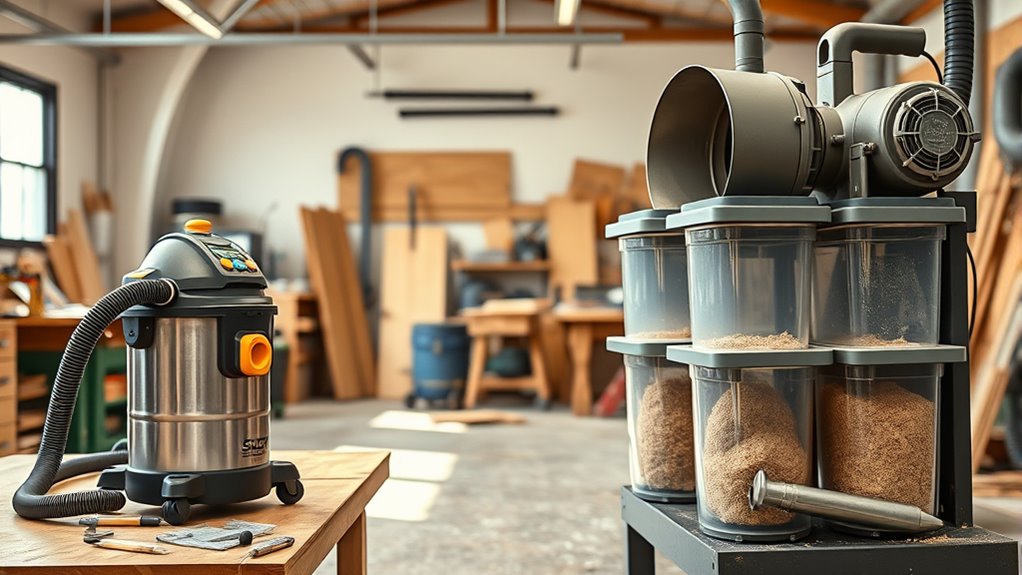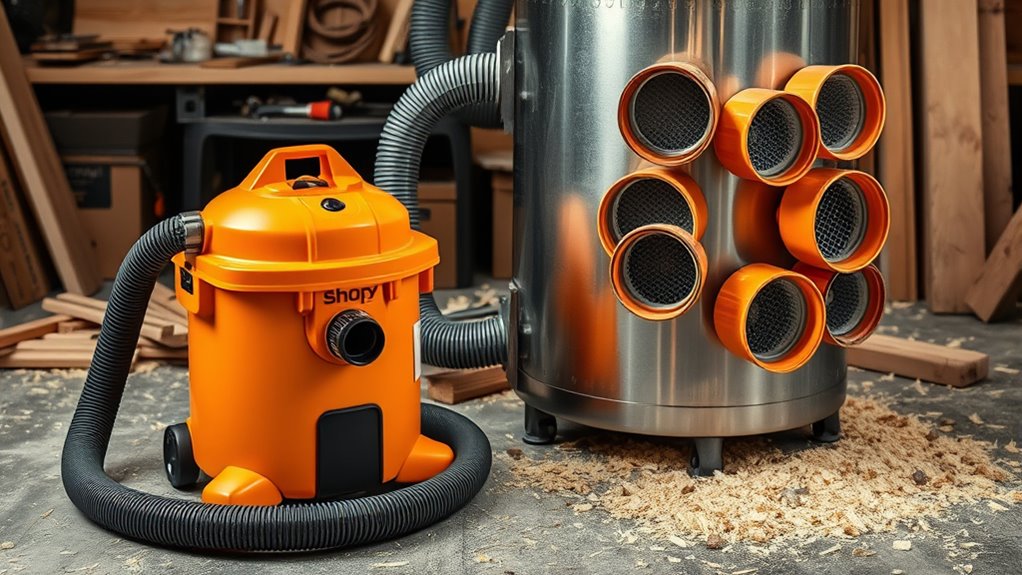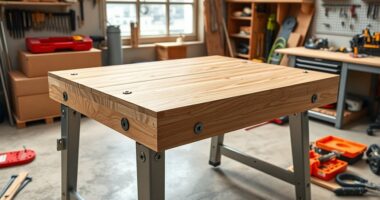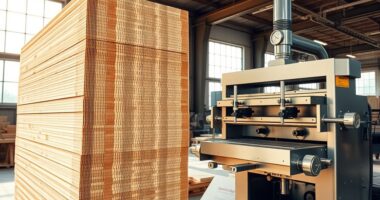If you’re choosing between a shop vac and a dust collector, consider their use cases and filters. Shop vacs are portable and versatile, perfect for quick cleanup of wet or dry debris around your workspace, but they usually lack high-efficiency filtration. Dust collectors are larger, stationary units designed for continuous, high-volume dust removal from stationary tools, often equipped with HEPA filters for cleaner air. To find out which suits your needs best, explore the differences further.
Key Takeaways
- Shop vacs are portable and versatile, ideal for quick cleanup of wet/dry spills and debris, while dust collectors are stationary and suited for continuous large-scale dust removal.
- Dust collectors usually feature high-efficiency filters like HEPA, providing better air quality and trapping fine dust particles; shop vacs generally have less advanced filtration.
- Shop vacs excel in mobility for tasks across different locations, whereas dust collectors are designed for fixed use with multiple stationary tools.
- Noise levels are higher in shop vacs due to their compact, powerful design, while dust collectors often operate quieter with sound-dampening features.
- Use cases depend on workspace needs: shop vacs for quick, versatile cleanup, and dust collectors for ongoing, high-volume dust extraction from multiple tools.

When choosing between a shop vac and a dust collector, understanding their differences can help you make the right decision for your workspace. One key aspect to contemplate is portable power. Shop vacs are designed to be highly portable, featuring compact sizes and built-in handles, so you can easily move them around your workshop or job site. This makes them ideal for quick cleanup jobs or tasks that require mobility. Dust collectors, on the other hand, tend to be larger and stationary, often installed in a fixed location to handle dust and debris from multiple tools simultaneously. If your work involves frequent, varied cleanup, a shop vac’s portability becomes a significant advantage. However, when dealing with large-scale dust extraction from stationary equipment, a dust collector’s fixed setup can provide continuous, efficient suction.
Shop vacs offer portability for quick cleanup, while dust collectors provide fixed, continuous dust extraction.
Noise levels are another critical factor. Shop vacs generally produce higher noise levels because they are small, powerful, and designed for portability, often operating at volume levels that can be quite loud, especially at maximum power. This can be disruptive during extended use or in shared workspaces. Dust collectors, while also noisy, tend to have larger, sound-dampening enclosures and operate at relatively lower noise levels compared to portable shop vacs. If you work in a shared environment or need to minimize noise, a dust collector might be the better option to keep your workspace comfortable and compliant with noise regulations. Conversely, if your workspace allows for louder equipment and you prioritize quick, on-the-spot cleanup, a shop vac’s louder operation might not be a deal-breaker.
In terms of use cases, shop vacs excel at versatile tasks — from cleaning up wet or dry spills to suctioning debris from power tools or even small woodworking projects. Their portability and ability to handle various messes make them a must-have for general maintenance. Dust collectors, however, are specialized for continuous, high-volume dust removal directly from woodworking machines, sanding stations, or other stationary tools. They typically feature higher-capacity filters, such as HEPA filters, designed to trap fine dust particles, improving air quality and reducing health risks. While shop vacs can handle some fine dust, they usually lack the filtration efficiency of dedicated dust collectors, which are essential for maintaining a cleaner, healthier workspace during large or ongoing woodworking projects. Additionally, the effectiveness of a dust collector can be significantly enhanced with proper filtration, ensuring safer air quality.
Ultimately, your choice hinges on the specific demands of your workspace and tasks. If you need portability for quick cleanup and versatile tasks, a shop vac is your best bet. If you require continuous, high-volume dust extraction with a focus on air quality, a dust collector’s stationary setup and filtration system will serve you better.
Frequently Asked Questions
Can Both Systems Handle Wet Debris Effectively?
Yes, both systems can handle wet debris effectively, but with limitations. A Shop Vac is designed for wet debris and uses water filtration to prevent clogs, making it ideal for liquid cleanup. Dust collectors typically aren’t built for water, as water can damage their filters and motors. So, for wet debris, a Shop Vac is your best choice, while dust collectors excel with dry dust and debris.
Which Is More Energy-Efficient for Continuous Use?
Imagine a steady stream of clean, efficient airflow guiding your work—this is what you get with a dust collector, making it more power-efficient for continuous use. Its optimized energy consumption means less strain on your power supply, unlike a Shop Vac, which uses more energy to maintain its suction. For ongoing projects, a dust collector’s energy-efficient design helps you save on electricity while keeping your workspace tidy and safe.
Are There Specific Brands Recommended for Durability?
If you’re looking for durability, some top brand recommendations include Festool, Jet, and Powermatic, as they’re known for sturdy construction and long-lasting performance. You should consider durability concerns when choosing a model, ensuring it’s built with quality materials. These brands offer reliable options that handle continuous use, giving you peace of mind and better value over time. Investing in reputable brands helps you avoid frequent replacements and maintenance hassles.
How Often Should Filters Be Replaced in Each System?
You should replace filters in both systems based on their filter lifespan and your replacement schedule. For shop vac filters, check them every 3 to 6 months, especially if used frequently, and replace when they show signs of wear or clogging. Dust collector filters typically last 6 to 12 months, but follow the manufacturer’s recommendations. Regularly inspecting filters guarantees maximum performance and air quality.
Can These Vacuums Be Used for Outdoor Cleanup Tasks?
Did you know that over 60% of people use their vacuums for outdoor cleanup? Yes, these vacuums can handle outdoor tasks, but weather resistance varies. Most shop vacs are suitable for outdoor cleanup, especially if they’re weather-resistant. However, dust collectors are generally designed for indoor use and may not withstand rain or humidity. Always check your vacuum’s weather resistance before tackling outdoor chores to avoid damage.
Conclusion
When choosing between a shop vac and a dust collector, think of it like picking the right tool for a job—each one shines in its own way. A shop vac is like a trusty handheld, perfect for quick cleanups, while a dust collector acts like a powerful floodgate, handling larger debris and fine dust. By understanding your specific needs, you can make a smart choice that keeps your workspace clean and safe, just like a well-oiled machine.









